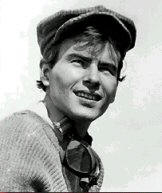In Remembrance: Horst Buchholz
 Horst Buchholz, the German actor who appeared in the classic western The
Magnificent Seven and Billy Wilder’s comedy One, Two, Thee, died
Monday, March 3, 2003 of pneumonia in Berlin, Germany. He was 69.
Horst Buchholz, the German actor who appeared in the classic western The
Magnificent Seven and Billy Wilder’s comedy One, Two, Thee, died
Monday, March 3, 2003 of pneumonia in Berlin, Germany. He was 69.
Born the son of a shoemaker on December 4, 1933 in Berlin’s working class Prenzlauer Berg district, he dropped out of school early to pursue acting lessons. He landed his first stage role at the age of 15 in an adaptation of the German children’s classic Emil and the Detectives. After achieving success on the Berlin stage, he segued to film with a bit part in the 1954’s Marianna de ma jeunesse (Marianne). His next role in Himmel ohne Sterne (Sky Without Stars, 1955) earned him a Cannes Film Festival Award in Silver for Outstanding Individual Achievement by a Young Actor or Actress. He followed this with a critically praised performance in the 1956 West German film Die Halbstarken (1956, Wolf Pack). It was this role, portraying a wavy-haired rebellious teen, which led him to be dubbed “Germany’s James Dean” by the press.
He first appeared on Broadway in the 1959 production of Cherie before heading to Hollywood where he landed a role as a gunslinger in 1960’s The Magnificent Seven along side Yul Brenner and Steve McQueen. In 1961 he co-starred in Billy Wilder’s One, Two, Three playing a communist who is secretly married Coca-Cola executive James Cagney’s boss’s daughter Pamela Tiffin.
He continued to make films in America as well as France, Spain, Italy and Britain. His last major film role was in Roberto Benigni’s La Vita e Bella (Life Is Beautiful, 1997).
“We actors are like whores,” Buchholz once said in an interview. “For a good film I’m the world’s biggest whore.”